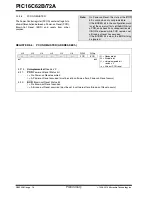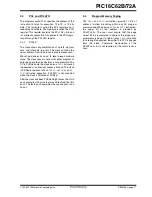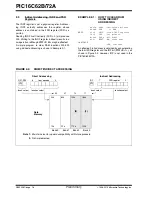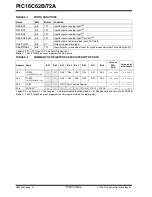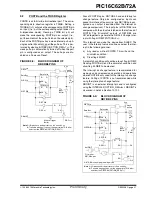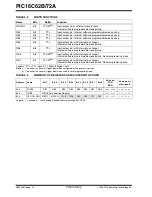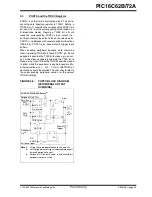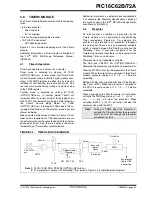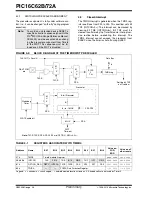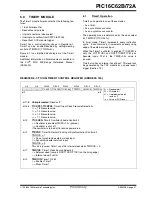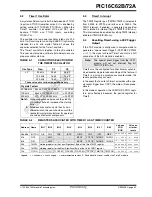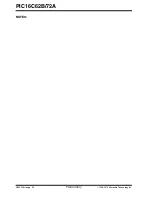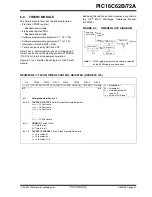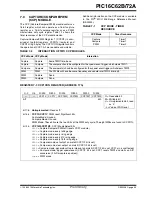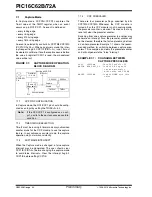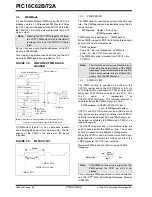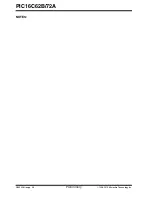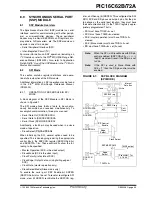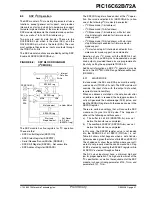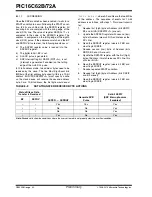
PIC16C62B/72A
1998-2013 Microchip Technology Inc.
Preliminary
DS35008C-page 29
5.2
Timer1 Oscillator
A crystal oscillator circuit is built-in between pins T1OSI
(input) and T1OSO (amplifier output). It is enabled by
setting control bit T1OSCEN (T1CON<3>). When the
Timer1 oscillator is enabled, RC0 and RC1 pins
become T1OSO and T1OSI inputs, overriding
TRISC<1:0>.
The oscillator is a low power oscillator rated up to 200
kHz. It will continue to run during SLEEP. It is primarily
intended for a 32 kHz crystal. Table 5-1 shows the
capacitor selection for the Timer1 oscillator.
The Timer1 oscillator is identical to the LP oscillator.
The user must provide a software time delay to ensure
proper oscillator start-up.
TABLE 5-1
CAPACITOR SELECTION FOR
THE TIMER1 OSCILLATOR
5.3
Timer1 Interrupt
The TMR1 Register pair (TMR1H:TMR1L) increments
from 0000h to FFFFh and rolls over to 0000h. The
TMR1 Interrupt, if enabled, is generated on overflow
and is latched in interrupt flag bit TMR1IF (PIR1<0>).
This interrupt can be enabled by setting TMR1 interrupt
enable bit TMR1IE (PIE1<0>).
5.4
Resetting Timer1 using a CCP Trigger
Output
If the CCP module is configured in compare mode to
generate a “special event trigger" (CCP1M3:CCP1M0
=
1011
), this signal will reset Timer1 and start an A/D
conversion (if the A/D module is enabled).
Timer1 must be configured for either timer or synchro-
nized counter mode to take advantage of this feature. If
Timer1 is running in asynchronous counter mode, this
reset operation may not work.
In the event that a write to Timer1 coincides with a spe-
cial event trigger from CCP1, the write will take prece-
dence.
In this mode of operation, the CCPR1H:CCPR1L regis-
ters pair effectively becomes the period register for
Timer1.
TABLE 5-2
REGISTERS ASSOCIATED WITH TIMER1 AS A TIMER/COUNTER
Osc Type
Freq
C1
C2
LP
32 kHz
33 pF
33 pF
100 kHz
15 pF
15 pF
200 kHz
15 pF
15 pF
These values are for design guidance only.
Crystals Tested:
32.768 kHz
Epson C-001R32.768K-A
20 PPM
100 kHz
Epson C-2 100.00 KC-P
20 PPM
200 kHz
STD XTL 200.000 kHz
20 PPM
Note 1:
Higher capacitance increases the stability
of oscillator but also increases the start-up
time.
2:
Since each resonator/crystal has its own
characteristics, the user should consult the
resonator/crystal manufacturer for appropri-
ate values of external components.
Note:
The special event trigger from the CCP1
module will not set interrupt flag bit
TMR1IF (PIR1<0>).
Address
Name
Bit 7
Bit 6
Bit 5
Bit 4
Bit 3
Bit 2
Bit 1
Bit 0
Value on
POR,
BOR
Value on
all other
resets
0Bh,8Bh
INTCON
GIE
PEIE
T0IE
INTE
RBIE
T0IF
INTF
RBIF
0000 000x
0000 000u
0Ch
PIR1
—
ADIF
—
—
SSPIF
CCP1IF
TMR2IF
TMR1IF
-0-- 0000
-0-- 0000
8Ch
PIE1
—
ADIE
—
—
SSPIE
CCP1IE
TMR2IE
TMR1IE
-0-- 0000
-0-- 0000
0Eh
TMR1L
Holding register for the Least Significant Byte of the 16-bit TMR1 register
xxxx xxxx
uuuu uuuu
0Fh
TMR1H
Holding register for the Most Significant Byte of the 16-bit TMR1 register
xxxx xxxx
uuuu uuuu
10h
T1CON
—
—
T1CKPS1 T1CKPS0 T1OSCEN T1SYNC TMR1CS TMR1ON
--00 0000
--uu uuuu
Legend:
x
= unknown,
u
= unchanged,
-
= unimplemented read as '0'. Shaded cells are not used by the Timer1 module.
Summary of Contents for PIC16C62B/72A
Page 4: ...PIC16C62B 72A DS35008C page 4 Preliminary 1998 2013 Microchip Technology Inc NOTES...
Page 30: ...PIC16C62B 72A DS35008C page 30 Preliminary 1998 2013 Microchip Technology Inc NOTES...
Page 38: ...PIC16C62B 72A DS35008C page 38 Preliminary 1998 2013 Microchip Technology Inc NOTES...
Page 48: ...PIC16C62B 72A DS35008C page 48 Preliminary 1998 2013 Microchip Technology Inc NOTES...
Page 80: ...PIC16C62B 72A DS35008C page 80 Preliminary 1998 2013 Microchip Technology Inc NOTES...
Page 104: ...PIC16C62B 72A DS35008C page 104 Preliminary 1998 2013 Microchip Technology Inc NOTES...
Page 110: ...PIC16C62B 72A DS35008C page 110 Preliminary 1998 2013 Microchip Technology Inc NOTES...
Page 120: ...PIC16C62B 72A DS35008C page 120 Preliminary 1913 Microchip Technology Inc...


